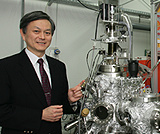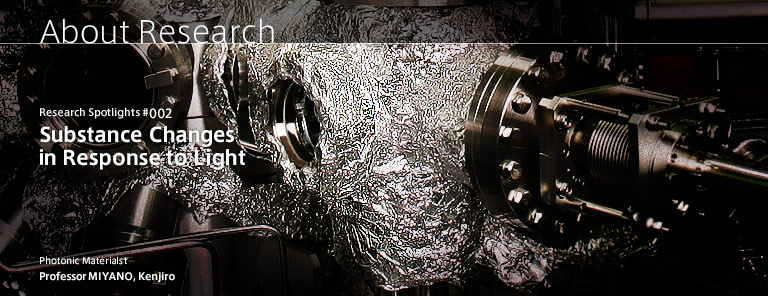Imagine a material that undergoes a drastic change in its property when illuminated with light. For example, its electrical resistance decreases to 1/1000th, then returns to normal. This strange phenomenon occurs in what looks like a commonplace, black metal oxide. Among substances that combine metal and oxygen with two more elements, there are some in which, when they are cooled to a temperature of nearly minus 200 degrees Celsius, a state is produced where electrons have strong, mutual interactions?these are called "strongly correlated electron systems."
"Apparently, there were occasional reports on this in the past, but they did not know that the quantity of the elements was important, and their experiments were not reproducible," says Professor Miyano. Currently, he changes the proportions of the elements by gradients of one percent, then takes measurements. Of course it is impossible to try out every combination, but he repeats sampling process in 100-nanometer (1/10,000th of a millimeter) thin films, and exposing them to light after they have been cooled.
Keeping an Eye on What is Going on Around You and Going with the Flow
Professor Miyano started his research on strongly correlated electron systems with the help of thin films four years ago, after moving from the Department of Engineering to RCAST, where he had a bigger laboratory and could set up his equipment. He says that to this very day, he has switched from one research field to the next by letting things unfold naturally. At one time, after failing the graduate school entrance exam that would have let him switch from engineering to science, he was thinking about finding a job, when he got some advice from his advisor. "He told me, ‘You will not be happy if you work for a large company,’ and then he suggested that I study abroad." After living and conducting research in the States for more than ten years, he was contacted by Tohoku University. "To begin with, I just went and got a feel for things there, then I thought about what I wanted to do." The fruits of his labors have been piling up ever since.
New Discoveries from Failed Data
Recently, he made another discovery. By changing not only the proportion of the components in his samples and the type of light exposure, but also the strength of the electric current when measuring electronic resistance, he was able to observe special properties.
Until then, he had been measuring at one microampere. After looking at large amounts of data, however, he noticed a number of strange phenomena, and when he tried changing the intensity of the current to 5 nanoamperes (that is, 1/200th of the initial strength) he realized that the temperature at which the properties of metal appeared was completely different.
"If a veteran researcher with years of experience got weird data like this, he or she might just say something like, 'The electrodes were not connected right,'" says Professor Miyano, but you have to pay attention when students report that they failed. There are also times when his students will not say anything, so he makes an effort to ask them, "How did it go yesterday?"

-
"All of the interesting phenomena that we have discovered started with someone giving a report that 'things did not go well.' I would say, 'Let's see,' and look at the data with them. We try it again together, then find something really fascinating happening."
Within the materials themselves are hidden any number of unpredictable discoveries that not even the smartest people can come up with through reason alone.
Interviewer: SUMIDA,Tomohisa
(November 8, 2005)


